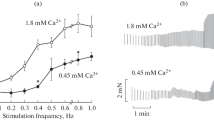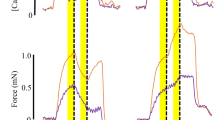Summary
Using frog heart strips at various Ca++-concentrations and temperatures dynamic stiffness and the release-recovery-phenomenon were studied by means of the quick-release technique.
-
1.
Dynamic stiffness depends only to a very small extend on Ca++-concentration and is practically independent of temperature. It depends mainly on muscle tension.
-
2.
However, the recovery tension following the rapid drop of tension during quick release increases if the [Ca++]/[Na+]2 quotient exceeds 5.5×10−4. Below this threshold, recovery force is independent of Ca++ and temperature.
-
3.
The Ca++-induced recovery tension rises with temperature (Q10 about 2).
From these findings it is concluded that the recovery force contains two components: one passive (viscous-elastic) and one active component, which is dependent on and induced by Ca++. The amplitude of the recovery-phenomenon is the arithmetical sum of both components.
Zusammenfassung
Mit Hilfe schneller Entdehnungen werden am Herzmuskelstreifen des Frosches die dynamische Steifheit und die elastische Nachspannung bei verschiedenen Ca++-Konzentrationen und Temperaturen gemessen.
-
1.
Die dynamische Steifheit wird von der Ca++-Konzentration nur sehr wenig beeinflußt und ist unabhängig von der Temperatur.
-
2.
Die dem raschen Spannungsabfall während der schnellen Entdehnung folgende elastische Nachspannung ist von der Ca++-Konzentration und der Temperatur unabhängig, wenn der Quotient [Ca++]/[Na+]2 kleiner als 5,5·10−4 ist. Oberhalb dieses Wertes wird die Nachspannung durch Ca++ vergrößert.
-
3.
Die von Ca++ ausgelöste zusätzliche Nachspannung steigt mit zunehmender Temperatur an.
Aus diesen Ergebnissen wird gefolgert, daß die Recoverykraft aus zwei Komponenten besteht: Einer passiven, viscös-elastischen und einer aktiven Komponente, die Ca++-abhängig ist. Beim aktiven Muskel ist die gesamte Recoverykraft die arithmetische Summe dieser beiden Komponenten.
Similar content being viewed by others
Literatur
Bleichert, A., u.H. Reichel: Die Hemmung der Erschlaffung beim Herzmuskel des Warm- und Kaltblüters. Pflügers Arch. ges. Physiol.276, 242 (1962).
Bommert, C.: Mechanische Eigenschaften des Herzmuskels im Zustand der Kontraktur. Z. Biol.113, 58 (1961).
Edman, K. A. P., D. W. Grieve, andE. Nilsson: Studies of the excitation-contraction mechanism in the skeletal muscle and the myocardium. Pflügers Arch. ges. Physiol.290, 320 (1966).
—, andE. Nilsson: The mechanical parameters of myocardial contraction studied at the constant length of the contractile element. Acta physiol. scand.72, 205 (1968).
Gasser, H. S., undA. V. Hill: Thermodynamics of muscular contraction. Proc. roy. Soc. B96, 398 (1924).
Gebert, G.: Die mechanische Reaktion des Froschskeletmuskels auf Ca++ und andere divalente Kationen in der Außenlösung. Pflügers Arch. ges. Physiol.296, 222 (1967).
Gibbs, C. L., W. F. H. Mommaerts, andN. V. Ricchiutti: Energetics of cardiac contractions. J. Physiol. (Lond.)191, 25 (1967).
Heilbrunn, L. V., andF. J. Wiercinski: The action of various cations on muscle protoplasma. J. cell. comp. Physiol.29, 15 (1947).
Huxley, F. E.: Sliding filament structure. In: Muscle, pp. 3–28. Ed. byW. M. Paul, E. E. Daniel, C. M. Kay, andG. Monckton. Oxford: Pergamon Press 1965.
Jewell, R. R., andD. R. Wilkie: An analysis of the mechanical components in frog's skeletal muscle. J. Physiol. (Lond.)143, 515 (1958).
——: The mechanical properties of relaxing muscle. J. Physiol. (Lond.)152, 30 (1960).
Lee, K. S.: The relationship of the oxygen consumption to the contraction of the cat papillary muscle. J. Physiol. (Lond.)151, 186 (1960).
Levin, A., andJ. Wyman: The viscous-elastic properties of muscle. Proc. roy. Soc. B101, 218 (1927).
Lundin, G.: Mechanical properties of cardiac muscle. Acta physiol. scand.7, Supplement XX (1944).
Lüttgau, H. C., andR. Niedergerke: The antagonism between Ca and Na ions on the frog's heart. J. Physiol. (Lond.)143, 486 (1958).
Niedergerke, R.: Local muscular shortening by intracellularly applied calcium. J. Physiol. (Lond.)128, 12 P (1955).
—: The potassium chloride contracture of the heart and its modification by calcium. J. Physiol. (Lond.)134, 584 (1956).
—: The rate of action of calcium ions on the contraction of the heart. J. Physiol. (Lond.)138, 506 (1957).
Pieper, H., H. Reichel u.E. Wetterer: Das Verhalten des ruhenden Skeletmuskels unter dem Einfluß aufgezwungener sinusförmiger Längenveränderungen. Z. Biol.104, 469 (1951).
Portzehl, H., P. C. Caldwell, andJ. C. Rüegg: The dependence of contraction and relaxation on muscle fibres from the crab maia squinado on the internal concentration of free calcium ions. Biochim. biophys. Acta (Amst.)79, 581 (1964).
Reichel, H.: Quantitative Beziehungen zwischen Ruhe- und Reizzustand des Skeletmuskels. Z. Biol.97, 429 (1936).
—: Muskelelastizität. Ergebn. Physiol.47, 469 (1952).
—: Muskelphysiologie. In: Lehrbuch der Physiologie. Berlin-Göttingen-Heidelberg: Springer 1960.
—, u.A. Bleichert: Hemmung der Erschlaffung beim Muskel. Pflügers Arch. ges. Physiol.275, 526 (1962).
—,F. Zimmer u.A. Bleichert: Die elastischen Eigenschaften des Skelet- und Herzmuskels in verschiedenen Phasen der Einzelzuckung. Z. Biol.108, 188 (1956).
Reiter, M.: Der Einfluß der Natriumionen auf die Beziehung zwischen Frequenz und Kraft der Kontraktion des isolierten Meerschweinchenmyokards. Naunyn-Schmiedebergs Arch. Pharmak. exp. Path.254, 261 (1966).
Ritchie, J. M., andD. R. Wilkie: The effect of previous stimulation on the active state of muscle. J. Physiol. (Lond.)130, 488 (1955).
Sonnenblick, E. H.: Active state in heart muscle-its delayed onset and modification by inotropic agents. J. gen. Physiol.50, 661 (1967).
Author information
Authors and Affiliations
Rights and permissions
About this article
Cite this article
Rumberger, E., Schwartz, B. Das Release-Recovery-Phänomen am Herzmuskel des Frosches bei variierten Ca++-Konzentrationen und Temperaturen. Pflugers Arch. 312, 149–160 (1969). https://doi.org/10.1007/BF00586926
Received:
Issue Date:
DOI: https://doi.org/10.1007/BF00586926
Key-words
- External Ca++-Concentration
- Heart Ventricle Strips of Frog
- Release-Recovery-Phenomenon
- Temperature Influence of Heart Muscle
- Dynamic Stiffness




